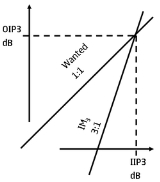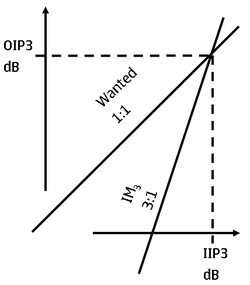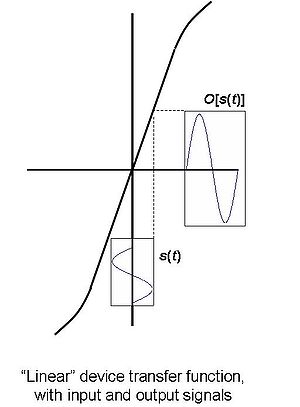
Third-order intercept point
Encyclopedia
In telecommunication
s, a third-order intercept point (IP3 or TOI) is a measure for weakly nonlinear systems and devices, for example receiver
s, linear amplifier
s and mixer
s. It is based on the idea that the device nonlinearity can be modeled using a low-order polynomial, derived by means of Taylor series
expansion. The third-order intercept point relates nonlinear products caused by the third-order nonlinear term to the linearly amplified signal, in contrast to the second-order intercept point
that uses second order terms.
The intercept point is a purely mathematical concept, and does not correspond to a practically occurring physical power level. In many cases, it lies beyond the damage threshold of the device.
It is worth noticing that these definitions differ by 4.8 dB (10 log10 3), so care should be taken when using existing equations, models or measurement data.
 The intercept point is obtained graphically by plotting the output power versus the input power both on logarithmic scale
The intercept point is obtained graphically by plotting the output power versus the input power both on logarithmic scale
s (e.g., decibels). Two curves are drawn; one for the linearly amplified signal at an input tone frequency, one for a nonlinear product.
On a logarithmic scale, the function xn translates into a straight line with slope of n. Therefore, the linearly amplified signal will exhibit a slope of 1. A third-order nonlinear product will increase by 3 dB in power when the input power is raised by 1 dB.
Both curves are extended with straight lines of slope 1 and n (3 for a third-order intercept point). The point where the curves intersect is the intercept point. It can be read off from the input or output power axis, leading to input or output intercept point, respectively (IIP3/OIP3).
Input and output intercept point differ by the small-signal gain of the device.
In practice, the weakly nonlinear assumption may not hold for the upper end of the input power range, be it during measurement or during use of the amplifier. As a consequence, measured or simulated data will deviate from the ideal slope of n.
The intercept point according to its basic definition should be determined by drawing the straight lines with slope 1 and n through the measured data at the smallest possible power level (possibly limited towards lower power levels by instrument or device noise).
It is a frequent mistake to derive intercept points by either changing the slope of the straight lines, or fitting them to points measured at too high a power level. In certain situations such a measure can be useful, but it is not an intercept point according to definition. Its value depends on the measurement conditions that need to be documented, whereas the IP according to definition is mostly unambiguous; although there is some dependency on frequency and tone spacing, depending on the physics of the device-under-test.
One of the useful applications of third order intercept point is as a rule-of-thumb measure to estimate nonlinear products. It can be seen that the spacing between two straight lines with slopes of 3 and 1 closes with slope 2.
For example, assume a device with an input-referred third-order intercept point of 10 dBm is driven with a test signal of −5 dBm. This power is 15 dB below the intercept point, therefore nonlinear products will appear at approximately 2x15 dB below the test signal power at the device output (in other words, 3×15 dB below the output-referred third-order intercept point).
A rule-of-thumb that holds for many linear radio frequency amplifiers is that the 1 dB compression point falls approximately 10 dB below the third-order intercept point.
 The third-order intercept point (TOI) is a property of the device transfer function O (see diagram).
The third-order intercept point (TOI) is a property of the device transfer function O (see diagram).
This transfer function relates the output signal voltage level to the input signal voltage level. We assume a “linear” device having a transfer function whose small signal form may be expressed in terms of a power series containing only odd terms, making the transfer function an odd function of input signal voltage, i.e., O[−s(t)] = −O[s(t)]. Where the signals passing through the actual device are modulated sinusoidal voltage waveforms (e.g., RF amplifier), device nonlinearities can be expressed in terms of how they affect individual sinusoidal signal components. For example, say the input voltage signal is the sine wave

and the device transfer function produces an output of the form

where G is the amplifier gain and D3 is cubic distortion. We may substitute the first equation into the second and, using the trigonometric identity

we obtain the device output voltage waveform as

The output waveform contains the original waveform, cos(ωt), plus a new harmonic term, cos(3ωt), the third-order. The coefficient of the cos(ωt) harmonic has two terms, one that varies linearly with V and one that varies with the cube of V. In fact, the coefficient of cos(ωt) has nearly the same form as the transfer function, except for the factor ¾ on the cubic term. In other words, as signal level V is increased, the level of the cos(ωt) term in the output eventually levels off, similar to how the transfer function levels off. Of course, the coefficients of the higher-order harmonics will increase (with increasing V) as the coefficient of the cos(ωt) term levels off (the power has to go somewhere).
If we now restrict our attention to that portion of the cos(ωt) coefficient which varies linearly with V, and then ask ourselves, at what input voltage level, V, will the coefficients of the first and third order terms have equal magnitudes (i.e., where the magnitudes intersect), we find that this happens when

which is the Third-Order Intercept Point (TOI). So, we see that the TOI input power level is simply 4/3 times the ratio of the gain and the cubic distortion term in the device transfer function. The smaller the cubic term is in relation to the gain, the more linear the device is and the higher the TOI is, which clearly makes sense. The TOI, being related to the magnitude squared of the input voltage waveform, is a power quantity, typically measured in milliwatts (mW). The TOI is always beyond operational power levels because the output power saturates before reaching this level.
The TOI is closely related to the amplifier's "1 dB compression point," which is defined as that point at which the total coefficient of the cos(ωt) term is 1 dB below the linear portion of that coefficient. We can relate the 1 dB compression point to the TOI as follows. Since 1 dB = 20 log10 1.122, we may say, in a voltage sense, that the 1dB compression point occurs when

or

or

In a power sense (V2 is a power quantity), a factor of 0.10875 corresponds to −9.636 dB, so by this approximate analysis, the 1 dB compression point occurs roughly 9.6 dB below the TOI.
Recall: decibel
figure = 10 dB × log10(power ratio) = 20 dB × log10(voltage ratio).
Telecommunication
Telecommunication is the transmission of information over significant distances to communicate. In earlier times, telecommunications involved the use of visual signals, such as beacons, smoke signals, semaphore telegraphs, signal flags, and optical heliographs, or audio messages via coded...
s, a third-order intercept point (IP3 or TOI) is a measure for weakly nonlinear systems and devices, for example receiver
Receiver (radio)
A radio receiver converts signals from a radio antenna to a usable form. It uses electronic filters to separate a wanted radio frequency signal from all other signals, the electronic amplifier increases the level suitable for further processing, and finally recovers the desired information through...
s, linear amplifier
Electronic amplifier
An electronic amplifier is a device for increasing the power of a signal.It does this by taking energy from a power supply and controlling the output to match the input signal shape but with a larger amplitude...
s and mixer
Frequency mixer
In electronics a mixer or frequency mixer is a nonlinear electrical circuit that creates new frequencies from two signals applied to it. In its most common application, two signals at frequencies f1 and f2 are applied to a mixer, and it produces new signals at the sum f1 + f2 and difference f1 -...
s. It is based on the idea that the device nonlinearity can be modeled using a low-order polynomial, derived by means of Taylor series
Taylor series
In mathematics, a Taylor series is a representation of a function as an infinite sum of terms that are calculated from the values of the function's derivatives at a single point....
expansion. The third-order intercept point relates nonlinear products caused by the third-order nonlinear term to the linearly amplified signal, in contrast to the second-order intercept point
Second-order intercept point
The Second Order Intercept Point, also known as the SOI, IP2, or IIP2 , is a measure of linearity that quantifies the second-order distortion generated by nonlinear systems and devices. Examples of frequently used devices that are concerned with this measure are amplifiers and mixers...
that uses second order terms.
The intercept point is a purely mathematical concept, and does not correspond to a practically occurring physical power level. In many cases, it lies beyond the damage threshold of the device.
Definitions
Two different definitions for intercept points are in use:- Based on harmonicHarmonicA harmonic of a wave is a component frequency of the signal that is an integer multiple of the fundamental frequency, i.e. if the fundamental frequency is f, the harmonics have frequencies 2f, 3f, 4f, . . . etc. The harmonics have the property that they are all periodic at the fundamental...
s: The device is tested using a single input tone. The nonlinear products caused by n-th order nonlinearity appear at n times the frequency of the input tone. - Based on intermodulation products: The device is fed with two sine tones with a small frequency difference. The n-th order intermodulation products then appear at n times the frequency spacing of the input tones. This two-tone approach has the advantage that it is not restricted to broadband devices and is commonly used for radio receivers.
It is worth noticing that these definitions differ by 4.8 dB (10 log10 3), so care should be taken when using existing equations, models or measurement data.

Logarithmic scale
A logarithmic scale is a scale of measurement using the logarithm of a physical quantity instead of the quantity itself.A simple example is a chart whose vertical axis increments are labeled 1, 10, 100, 1000, instead of 1, 2, 3, 4...
s (e.g., decibels). Two curves are drawn; one for the linearly amplified signal at an input tone frequency, one for a nonlinear product.
On a logarithmic scale, the function xn translates into a straight line with slope of n. Therefore, the linearly amplified signal will exhibit a slope of 1. A third-order nonlinear product will increase by 3 dB in power when the input power is raised by 1 dB.
Both curves are extended with straight lines of slope 1 and n (3 for a third-order intercept point). The point where the curves intersect is the intercept point. It can be read off from the input or output power axis, leading to input or output intercept point, respectively (IIP3/OIP3).
Input and output intercept point differ by the small-signal gain of the device.
Practical considerations
The concept of intercept point is based on the assumption of a weakly nonlinear system, meaning that higher-order nonlinear terms are small enough to be negligible.In practice, the weakly nonlinear assumption may not hold for the upper end of the input power range, be it during measurement or during use of the amplifier. As a consequence, measured or simulated data will deviate from the ideal slope of n.
The intercept point according to its basic definition should be determined by drawing the straight lines with slope 1 and n through the measured data at the smallest possible power level (possibly limited towards lower power levels by instrument or device noise).
It is a frequent mistake to derive intercept points by either changing the slope of the straight lines, or fitting them to points measured at too high a power level. In certain situations such a measure can be useful, but it is not an intercept point according to definition. Its value depends on the measurement conditions that need to be documented, whereas the IP according to definition is mostly unambiguous; although there is some dependency on frequency and tone spacing, depending on the physics of the device-under-test.
One of the useful applications of third order intercept point is as a rule-of-thumb measure to estimate nonlinear products. It can be seen that the spacing between two straight lines with slopes of 3 and 1 closes with slope 2.
For example, assume a device with an input-referred third-order intercept point of 10 dBm is driven with a test signal of −5 dBm. This power is 15 dB below the intercept point, therefore nonlinear products will appear at approximately 2x15 dB below the test signal power at the device output (in other words, 3×15 dB below the output-referred third-order intercept point).
A rule-of-thumb that holds for many linear radio frequency amplifiers is that the 1 dB compression point falls approximately 10 dB below the third-order intercept point.
Theory

This transfer function relates the output signal voltage level to the input signal voltage level. We assume a “linear” device having a transfer function whose small signal form may be expressed in terms of a power series containing only odd terms, making the transfer function an odd function of input signal voltage, i.e., O[−s(t)] = −O[s(t)]. Where the signals passing through the actual device are modulated sinusoidal voltage waveforms (e.g., RF amplifier), device nonlinearities can be expressed in terms of how they affect individual sinusoidal signal components. For example, say the input voltage signal is the sine wave

and the device transfer function produces an output of the form

where G is the amplifier gain and D3 is cubic distortion. We may substitute the first equation into the second and, using the trigonometric identity

we obtain the device output voltage waveform as

The output waveform contains the original waveform, cos(ωt), plus a new harmonic term, cos(3ωt), the third-order. The coefficient of the cos(ωt) harmonic has two terms, one that varies linearly with V and one that varies with the cube of V. In fact, the coefficient of cos(ωt) has nearly the same form as the transfer function, except for the factor ¾ on the cubic term. In other words, as signal level V is increased, the level of the cos(ωt) term in the output eventually levels off, similar to how the transfer function levels off. Of course, the coefficients of the higher-order harmonics will increase (with increasing V) as the coefficient of the cos(ωt) term levels off (the power has to go somewhere).
If we now restrict our attention to that portion of the cos(ωt) coefficient which varies linearly with V, and then ask ourselves, at what input voltage level, V, will the coefficients of the first and third order terms have equal magnitudes (i.e., where the magnitudes intersect), we find that this happens when

which is the Third-Order Intercept Point (TOI). So, we see that the TOI input power level is simply 4/3 times the ratio of the gain and the cubic distortion term in the device transfer function. The smaller the cubic term is in relation to the gain, the more linear the device is and the higher the TOI is, which clearly makes sense. The TOI, being related to the magnitude squared of the input voltage waveform, is a power quantity, typically measured in milliwatts (mW). The TOI is always beyond operational power levels because the output power saturates before reaching this level.
The TOI is closely related to the amplifier's "1 dB compression point," which is defined as that point at which the total coefficient of the cos(ωt) term is 1 dB below the linear portion of that coefficient. We can relate the 1 dB compression point to the TOI as follows. Since 1 dB = 20 log10 1.122, we may say, in a voltage sense, that the 1dB compression point occurs when

or

or

In a power sense (V2 is a power quantity), a factor of 0.10875 corresponds to −9.636 dB, so by this approximate analysis, the 1 dB compression point occurs roughly 9.6 dB below the TOI.
Recall: decibel
Decibel
The decibel is a logarithmic unit that indicates the ratio of a physical quantity relative to a specified or implied reference level. A ratio in decibels is ten times the logarithm to base 10 of the ratio of two power quantities...
figure = 10 dB × log10(power ratio) = 20 dB × log10(voltage ratio).

